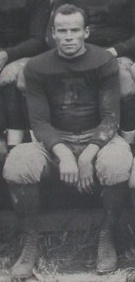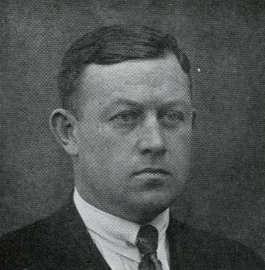
The Boston College Eagles are the athletic teams that represent Boston College, located in Chestnut Hill, Massachusetts. They compete as a member of the National Collegiate Athletic Association (NCAA) Division I level, primarily competing in the Atlantic Coast Conference (ACC).

The Green Line Rivalry, also known as the B-Line Rivalry, the Battle of Boston and Battle of Commonwealth Avenue, is the name for the sports rivalry between Boston College and Boston University. The rivalry is named after the Green Line, a light rail line that runs along Commonwealth Avenue and links the two schools as part of the MBTA, Boston's public transit system. The two campuses lie less than five miles apart.

James R. Ludlow "Lud" Wray was a professional American football player, coach, and co-founder, with college teammate Bert Bell, of the Philadelphia Eagles of the National Football League. He was the first coach of the Boston Braves and of the Eagles. He also served as head coach at his alma mater, the University of Pennsylvania.

Oliver Frost Cutts was an American football player, coach, and college athletics administrator. He served as the head football coach at Purdue University (1903–1904), the University of Washington (1905), and Bates College (1922–1923), compiling a career college football record of 23–18–3. Cutts was also the athletic director at Purdue from 1904 to 1905 and again from 1915 to 1918. He died on August 4, 1939 at his home in the Jamaica Plain neighborhood of Boston, Massachusetts.

Eugene Joseph "Gene" Goodreault, was an American football player. He played at the end position for Boston College from 1938 to 1940 and was selected as a consensus first-team All-American in 1940. He was inducted into the College Football Hall of Fame in 1982.

Percy Duncan Haughton was an American football and baseball player and coach. He served as head football coach at Cornell University from 1899 to 1900, at Harvard University from 1908 to 1916, and at Columbia University from 1923 to 1924, compiling a career college football record of 97–17–6. The Harvard Crimson claimed national champions for three of the seasons that Haughton coached: 1910, 1912, and 1913. Haughton was also Harvard's head baseball coach in 1915 and part owner of the Boston Braves from 1916 to 1918. He was inducted into the College Football Hall of Fame as a coach in 1951.

Charles Edward Brickley was an American football player and coach. He served as the head football coach at the Johns Hopkins University in 1915, at Boston College from 1916 to 1917, and at Fordham University in 1920 with Joseph DuMoe as co-coach, compiling a career college football record of 22–9. Brickley also coached the New York Brickley Giants of the American Professional Football Association—now the National Football League—in 1921, tallying a mark of 0–2.

Francis Joseph Morrissey was an American football player and coach. He played college football at Boston College from 1917 and 1920 and also served as head football coach in 1918.

William Harold "Butch" Cowell was an American football player and coach of football, basketball, and baseball. He is best known for his tenure as head coach of the New Hampshire Wildcats football team from 1915 to 1936.
The Tufts Jumbos represent Tufts University of Medford, Massachusetts in the sport of college football. The team has played since the 1874–75 season. The Tufts football team played its first game on June 4, 1875 against Harvard, which Tufts won by a score of 1–0. This game is considered the first game of American football between two American colleges, with each team fielding 11 men, the ball being advanced by kicking or carrying it, and tackles of the ball carrier stopping play. The Jumbos compete at the NCAA Division III level and have been members of the New England Small College Athletic Conference (NESCAC) since the conference's formation in 1971. The football team plays its home game at Ellis Oval on the Tufts campus in Medford. Jay Civetti has been the team's head coach since 2011. One Tufts player, William Grinnell, has been inducted into the College Football Hall of Fame.

The 1918 college football season was a season of college football in the United States. There was no consensus champion, with the Official NCAA Division I Football Records Book listing Michigan and Pittsburgh as national champions.
John White "Jack" Hallowell was an American football player and businessman. He played college football at Harvard University and was a consensus All-American at the end position in 1900.
The 1918 Purdue Boilermakers football team was an American football team that represented Purdue University during the 1918 Big Ten Conference football season. In their first season under head coach A. G. Scanlon, the Boilermakers compiled a 3–3 record, finished in a tie for first place in the Big Ten Conference with a 1–0 record against conference opponents, and outscored all opponents by a combined total of 87 to 78.
The 1918 Dartmouth football team represented Dartmouth College in the 1918 college football season.
The 1918 Mineola Aviation Station football team represented the United States Army aviators stationed at Mineola Aviation Station on Long Island during the 1918 college football season.
The 1918 Brown Bears football team represented Brown University during the 1918 college football season.
The 1918 Camp Devens football team was an American football team that represented the United States Army stationed at Camp Devens in Ayer, Massachusetts, during the 1918 fall football season. George Hoban served as both the team captain and coach. The team compiled a 4–2 record.

The 1918 New Hampshire football team was an American football team slated to represent New Hampshire College of Agriculture and the Mechanic Arts during the 1918 college football season—the school became the University of New Hampshire in 1923. However, due to World War I, the varsity season was cancelled. The school did field a team composed of Student Army Training Corps (SATC) personnel, which played a five-game schedule.
The 1918 Fordham Maroon football team was an American football team that represented Fordham University as an independent during the 1918 college football season. Fordham claims a 16–2–1 record. College Football Data Warehouse (CFDW) lists the team's record at 4–2–1. Opponents recognized by CFDW are displayed in bold in the schedule chart below.
The 1918 Lehigh Brown and White football team was an American football team that represented Lehigh University as an independent during the 1918 college football season. In its seventh season under head coach Tom Keady, the team compiled a 4–3 record and outscored opponents by a total of 92 to 58. The team played its home games at Taylor Stadium in Bethlehem, Pennsylvania.










